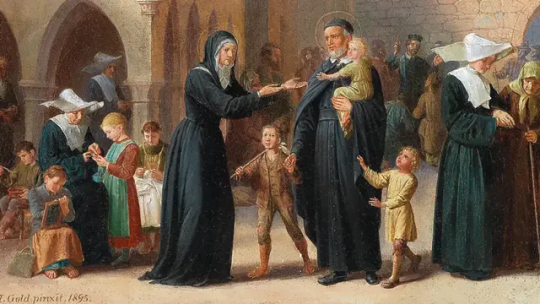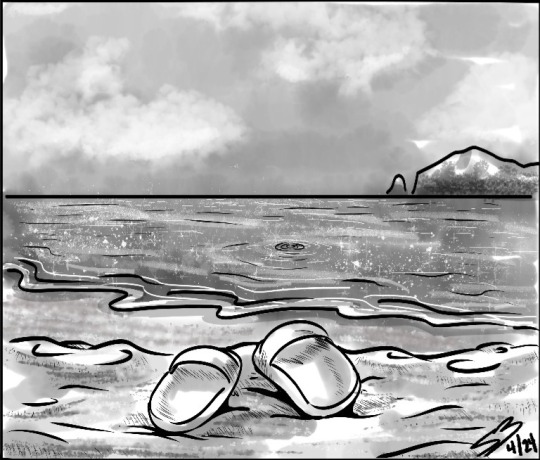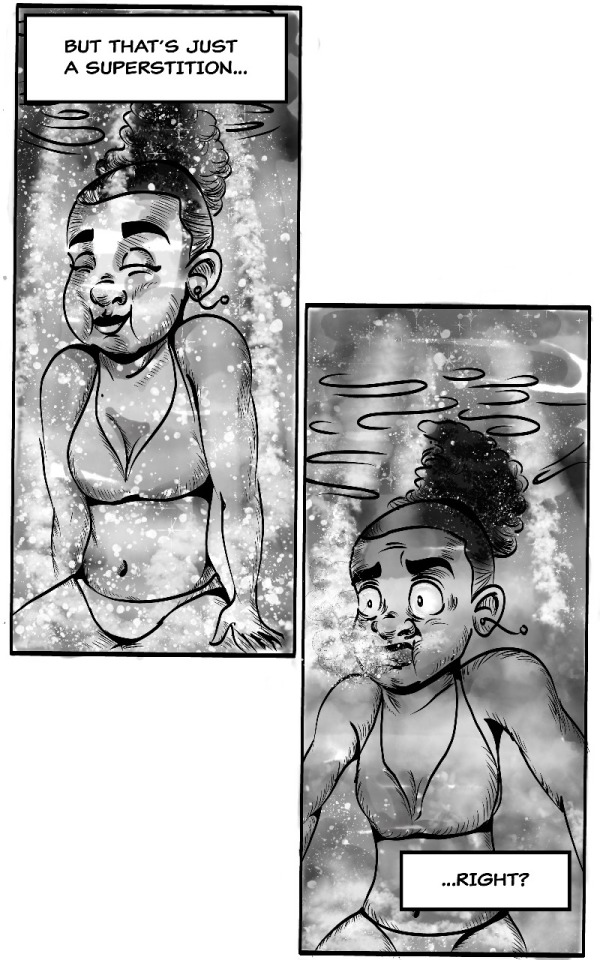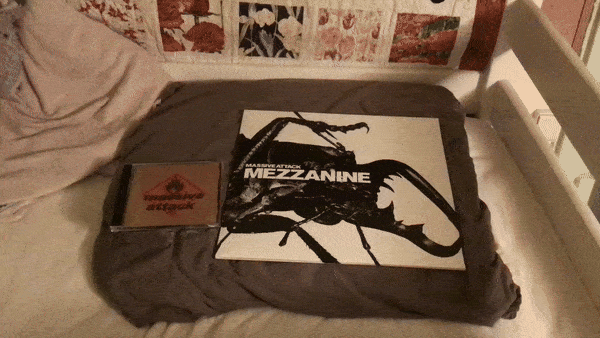#vincentian
Explore tagged Tumblr posts
Text
Brooklyn Charity: A Diocesan/Vincentian Partnership
There was Catholic Charity in Brooklyn before it was a diocese, before it was a city, and long before the day that Father William J. White was named the first diocesan supervisor of Catholic Charities.
This is the opening line to the "History of Catholic Charities: Diocese of Brooklyn." Monsignor William White would eventually be given the task to coordinate the various charitable activities of Brooklyn on April 1st, 1899 but records show that the earliest Catholic institution to promote charity in Brooklyn took place on October 1829. Responding to the needs of orphans The Roman Catholic Orphan Asylum Society was formed in Brooklyn and an instrumental partner in the housing of these "foundlings" was Elizabeth Ann Seton's Sisters of Charity, a religious community of women who adapted the Vincentian rule.
Of course it must be recognized that the care of orphans, besides being one of the oldest biblical works of mercy along with the care of widows and foreigners, was the earliest charitable program of St. Vincent DePaul's himself. in 1638 St. Vincent, alongside St. Louise de Marillac and her sisters, would organize safe lodging for the orphabed children of Paris. St. Vincent would establish a rule for the daughters of charity based on this charitable mission.
They will reflect that their ministry is to serve the Infant Jesus in the person of each baby they are raising, and in this they have the honor of doing what the Blessed Virgin did to her dear Son, since He affirms that the service rendered to the least of His people is rendered to Himself. In accordance with that, they will do their utmost to raise these poor children with as much attention and respect as if it were to the very person of Our Lord.” (Vincent DePaul, n.d., 13b: 209)

Eventually the diocese would take shape in 1853 when Bishop John Loughlin was installed. Loughlin established an enduring legacy for the role that charity would have in this diocese. In some ways he was a maverick who prioritized charitable programs over the development of its own Cathedral which remained fairly humble. It appears that he was a thorn of the side to Archbishop Michael Corrigan (who was portrayed having issues with another champion of charity, Mother Cabrini in the recent movie "Cabrini") for Loughlin's unwavering support of charity and social justice when Corrigan wanted to play nice with the powers that be. Throughout this entire time the Vincentians were a perfect partner in crime. In 1855 Loughlin supported the foundation of a St. Vincent DePaul conference. At that time the society had only existed for 20 years. Bishop Loughlin was no stranger to the spirituality and gifts of this community. As a young priest in New York he sponsored the first conference into the city. With charity as a central focus of the Brooklyn Catholic community (at that time engulfing all of Long Island) the the relationship between the developing diocese and the Vincentian community was an obvious one.
The tie that binds our two Catholic institutions is our commitment to institutional charity. The field of social work originates from this orientation. While charity is a core value for all Catholics, it was the works of Sts. Vincent and Louise and the community that followed which took seriously the institutionalization of our social ministries. The Vincentian charism challenges us to see Christ in the face of those in need and what this means for our social ministries. Bl. Frederic Ozanam, the founder of the St. Vincent DePaul Societies, continued developing the social ministry framework that is crucial for us today.
Almsgiving alone, alms that are not accompanied by words and love, is a humiliation for the one who receives it. Do we need to remember that man does not live by bread alone, that the Savior himself does not only ask to be clothed and fed in the person of the poor, but also visited and consoled? Will we have to expose everything that the masters of charity up to St. Vincent de Paul have taught us about the delicate behavior that takes into account the legitimate susceptibility of the poor?
St. Vincent DePaul and the diocese of Brooklyn may have started with addressing the needs of the orphans but it did not end there. Sts. Vincent and Louise organized centers of care and hospitality for refugees. They provided assistance to many who were displaced. They organized food distribution and soup kitchens. They also provided for education and job training. Today the Vincentian community is a worlwide phenomenon established in the service industries, of social work, health care, and education. They continue to be recognized for their ongoing prison and parish social ministries. They are now leaders in the field of promoting systemic change with creative microlending projects like St. John's G.L.O.B.E initiative.
As already mentioned, in 1899 Bishop McDonnell re-organized the charitable ministries in the Brooklyn Diocese and institutionalized our Catholic Charities agency. By 1913 when Brooklyn Catholic Charities had its second director, Fr. Francis O'Hara, Catholic Charities had nearly fifty charitable institutions. Today, under the leadership of the 8th Bishop of Brooklyn Bishop Robert Brennan and CCBQ's present CEO Monsignor Alfred LoPinto, Catholic Charities of the Diocese of Brooklyn runs 160 programs including food distributions, case management, migrant assistance, ESL, workforce development, behavioral health, early childhood programs, housing for seniors and the disabled.
But as we celebrate our 125th anniversary we dare not forget that all this effort began through an essential partnership with our Vincentian brothers and sisters. There is an amazing convergence between the mission of our two organizations. As we celebrate this milestone we do it stretching our hand to our dear friends in order to make sure that we continue to serve this legacy together.

0 notes
Text

Emma Prempeh (b. 1996) is a British artist with Ghanaian and Vincentian heritage based in London. The starting point to Prempeh’s paintings is the matter of blackness – the tonal properties of the colour establishes the ground to her paintings and a cinematic basis to invoke and project memories of events, people, and places to emphasise an appreciation of ancestral time and relationships, selfhood and transformation. Schlag metal, a brass alloy of copper and zinc imitative of gold leaf, is a material that Prempeh applies to selected areas of her often large-scale paintings. Over time this oxidises creating slow, live visual changes that animate the image and create a meta-narrative around our experiences of the passing of time, memory and its representation. Prempeh occasionally experiments with projected still and moving imagery to create painting installations that invite other experiential and performative encounters with her work. https://vocurations.com/artists/emma-prempeh
8 notes
·
View notes
Text



A lil (late) Good Friday horror comic.
There's a well known superstition that one must never go swimming, or even to the beach on Good Friday because without fail someone has drowned.
there was a discussion on caribbean Twitter talking about making a horror short story/film about this superstition and I couldn't get it out of my head, so this was my take on it!
experimenting with black and white and watercolour brushes in fresco!
#art#my art#illustration#digital art#adobe fresco#black and white#watercolour#comic#horror#horror comic#good friday#easter#superstitions#caribbeam superstitions#caribbean folklore#caribbean art#caribbean artist#vincentian art#vincentian artist
16 notes
·
View notes
Text
Stolen Jewelry and a Stubbed Toe
It was a typical Wednesday at the Vincentian Family Center — laughing with volunteers, helping shoppers find treasures, and watching joy unfold in unexpected places. Whether someone came looking for a bargain or just curiosity brought them in, one thing was certain: needs were being met, and hearts were being lifted. Where else can you find quality items at 50% off retail and still leave…
#abundant life#bargain#blog#christian#earrings#facebook#generosity#grace#inspiration#Jesus restores#John 10:10#joy#no tags#old clothes#redemption#shoppers#stolen jewelry#stolen peace#stubbed toe#Vincentian Family Center#volunteers
0 notes
Text

Sexypink - What do we know about filmmakers and filmmaking in St. Vincent? We better get in the know!


Sexypink - St.Vincentian Filmmakers.

Sexypink - remember these St. Vincent Filmmakers.

Sexypink - exciting things happen when we tell our own stories.

Sexypink

Sexypink

Sexypink

#sexypink/St.Vincentian Filmmakers#St.Vincent#sexypink/Hayden K Billingy#sexypink/Sean Roache#sexypink/Jemmel Williams#Tumblr/ St. Vincentian Filmmakers#Jemmel Williams#Sean Roache#Hayden K Billingy#Javed Desouza#filmmaking
0 notes
Text
Antigua St Vincent Mix Butterfly: A Unique Blend of Tradition and Fashion
The Antigua St Vincent Mix Butterfly is a captivating blend of two distinct Caribbean butterfly species, combining the unique characteristics of butterflies native to Antigua and St Vincent. This

Buy now:19.95$
hypothetical hybrid showcases the vibrant biodiversity of the Caribbean islands and the potential for cross-island pollination.
This imaginary butterfly boasts a striking appearance, with wings that display a mesmerizing fusion of colors and patterns. The upper wings might feature the bold, tropical hues typical of Antiguan butterflies, while the lower wings could exhibit the intricate designs found on St Vincent's native species. This results in a visually stunning insect that captures the essence of both islands' natural beauty.
The Antigua St Vincent Mix Butterfly would likely demonstrate remarkable adaptability, thriving in various Caribbean ecosystems. Its diet might consist of nectar from flowers native to both islands, making it an important pollinator for a wide range of plant species.

Buy now
Lepidopterists and nature enthusiasts would be particularly intrigued by this unique butterfly, as it would represent a fascinating subject for study in terms of genetics, adaptation, and island ecology. Its existence could potentially shed light on the interconnectedness of Caribbean ecosystems and the effects of climate change on insect populations in the region.
While this mixed butterfly is purely fictional, it serves as an intriguing concept that highlights the rich biodiversity of the Caribbean and the potential for unexpected natural hybridization in island environments. It also underscores the importance of conservation efforts to protect the unique flora and fauna of these tropical paradises.
Antiguan and Vincentian roots represent the rich cultural heritage of two distinct Caribbean nations: Antigua and Barbuda, and Saint Vincent and the Grenadines. These roots are deeply intertwined with the islands' histories, shaped by indigenous Arawak and Carib peoples, European colonization, and African influences brought by the slave trade.

Buy now
Both cultures share similarities in their vibrant music, with calypso and soca rhythms pulsing through their traditions. Their cuisines feature local ingredients like breadfruit, saltfish, and tropical fruits, creating unique flavors that reflect their island environments.
Antiguan and Vincentian roots also encompass a strong sense of community, resilience in the face of historical adversity, and a connection to the natural beauty of their islands. While each nation maintains its distinct identity, their shared Caribbean heritage creates a bond that transcends national borders.
Butterfly gifts for her offer a delightful array of options that capture feminine charm and natural beauty. These might include elegant butterfly-themed jewelry such as necklaces, earrings, or bracelets. Home décor items like butterfly-patterned throw pillows, wall art, or delicate wind chimes can add a touch of whimsy to her living space. For fashion enthusiasts, butterfly-adorned scarves, handbags, or hair

Buy now
accessories make stylish presents. Other thoughtful options include butterfly-inspired garden ornaments, stationery sets, or fragrant candles, all celebrating the grace and symbolism of these enchanting creatures.
#Antiguan Vincentian Heritage#Antiguan and Vincentian Culture#Caribbean Ancestry#Roots Run Deep#Island Pride#Butterfly Gifts#Gifts for Her#Women's Butterfly Gifts#Butterfly Presents#Unique Gifts for Her#Caribbean Butterfly#Antigua Butterfly#St Vincent Butterfly#Island Butterfly#Exotic Butterfly#View all AUTISM GIFTS products: https://zizzlez.com/trending-topics/hobbies/autism-spectrum-awareness-month/#All products of the store: https://zizzlez.com/
0 notes
Text

I am deeply in love with this photo of myself. It is because I am smiling & didn't expect to look that beautiful smiling. I have been loving my smile more and more with time. It feels unreal that I used to hate it.
My eyes are also so stunning! I love my eyes! Honestly, I am loving how I look lately. I am practicing loving on my physical appearance more and being in my body more since I used to only focus on my internal state of being. It is time to give my physical reality & body some love.
It is time to be present in reality.
#my face#my thoughts#self love#beauty#neptune shares#positivity#queer#nonbinary#genderfluid#mixed race#vincentian#west indian#multiethnic#sapphic#aries sun#septum piercing#pansexual#love#poc#polyamorous
15 notes
·
View notes
Text

1 note
·
View note
Text



Galleryyuhself - St. Vincentian Chocolate gets its moment.
#galleryyuhself/St. Vincentian Chocolate#galleryyuhself/London Dessert Company St.Vincent and the Grenadines#galleryyuhself/St.Vincent#tumblr/advertising in St.Vincent#tumblr/LDC St.Vincent#tumblr/Vincentian chocolate#food restaurants#St.Vincent and the Grenadines#St.Vincent chocolate
0 notes
Text
#dominica#st lucia#st vincent & the grenadines#dominicans🇩🇲#st lucians#vincentians#lucians#vincies#grenada#grenadians#alcohol tolerance
1 note
·
View note
Text
“The Gospel takes away our right forever, to discriminate between the deserving and the undeserving poor.” Servant of God, Dorothy Day
“The mystery of the poor is this: That they are Jesus, and what you do for them you do for Him. It is the only way we have of knowing and believing in our love. The mystery of poverty is that by sharing in it, making ourselves poor in giving to others, we increase our knowledge of and belief in love.” Servant of God, Dorothy Day
hatehatehate how christianity chooses to deal with homeless people and addicts
#simply say you’ve never heard of Catholic worker house or Vincent de Paul society or Catholic charities or the Franciscans or Vincentians#or poor Clares or mother Teresa or Francis or Dorothy day or the countless#saints that make serving the poor their only goal and purpose#god mystically dwells in the poor#the Bible honors the poor more than just about everything
24 notes
·
View notes
Text
Shoutout to Caribbean LGBTQ+ folks.
Some identities below have folks who do not always consider themselves Caribbean, so if you are one of these identities and don’t identify as Caribbean, that is okay and you are just as loved :)
Shoutout to all Puerto Rican LGBTQ+ folks.
Shoutout to all Belizean LGBTQ+ folks.
Shoutout to all Aruban LGBTQ+ folks.
Shoutout to all Kalinago LGBTQ+ folks.
Shoutout to all Jamaican LGBTQ+ folks.
Shoutout to all Cuban LGBTQ+ folks.
Shoutout to all Antiguan and Barbudan LGBTQ+ folks.
Shoutout to all Bahamian LGBTQ+ folks.
Shoutout to all Martinican LGBTQ+ folks.
Shoutout to all Dominican LGBTQ+ folks.
Shoutout to all Guianese LGBTQ+ folks.
Shoutout to all Saint Martinois LGBTQ+ folks.
Shoutout to all Caymanian LGBTQ+ folks.
Shoutout to all US Virgin Islander LGBTQ+ folks.
Shoutout to all Statian LGBTQ+ folks.
Shoutout to all Haitian LGBTQ+ folks.
Shoutout to all Turks and Caicos Islander/Belonger LGBTQ+ folks.
Shoutout to all Surinamese LGBTQ+ folks.
Shoutout to all Montserratian LGBTQ+ folks.
Shoutout to all Anguillian LGBTQ+ folks.
Shoutout to all Curaçaoan LGBTQ+ folks.
Shoutout to all Barbadian/Bajan LGBTQ+ folks.
Shoutout to all Sabian LGBTQ+ folks.
Shoutout to all Creole LGBTQ+ folks.
Shoutout to all Vincentian LGBTQ+ folks.
Shoutout to all Grenadian LGBTQ+ folks.
Shoutout to all St. Barthélemyan LGBTQ+ folks.
Shoutout to all Bermudian LGBTQ+ folks.
Shoutout to all Lokono LGBTQ+ folks.
Shoutout to all Guadeloupean LGBTQ+ folks.
Shoutout to all British Virgin Islander LGBTQ+ folks.
Shoutout to all Trinidadian and Tobagonian LGBTQ+ folks.
Shoutout to all Taíno LGBTQ+ folks.
Shoutout to all Garifuna LGBTQ+ folks.
Shoutout to all Guyanese LGBTQ+ folks.
Shoutout to all Kittitian and Nevisian LGBTQ+ people.
Shoutout to all Saint Lucian LGBTQ+ folks.
Take pride in it all. Your culture, your identity, it’s all so beautiful. Celebrate where you are from and who you are. It makes you you, and that is something to be proud of.
Post for Native Americans, post for Africans, post for Middle Easterners, post for Asians, post for Pacific Islanders, post for Oceanic folks
#please make me aware if any are incorrect or missing#mental health#Caribbean#positivity#self care#mental illness#self help#recovery#lgbt#lgbtq#lgbtqia#lgbt positivity#lgbtq positivity#gay#pride#lesbian#wlw#sapphic#bi#bisexual#trans#transgender#queer#pansexual#intersex#asexual#aromantic#aroace#nonbinary#genderfluid
100 notes
·
View notes
Text
Love Has No Limits
Love Has No LimitsVolunteering at the Vincentian Family Center brings me joy. Every Saturday, nearly 1,000 families receive food, and I serve in the thrift store, where people from all walks of life come through the doors — some searching for bargains, others for basic necessities. There’s a homeless man who comes directly to me at the store. He carries his few possessions in a plastic bag. He…
#blog#child of god#christian#faith#homeless man#inspiraton#James 2:2-4#judging#lamplighters#love has no limits#love like Jesus#seed planted#Vincentian Family Center#whosoevers
0 notes
Text
The [...] British quest for Tahitian breadfruit and the subsequent mutiny on the Bounty have produced a remarkable narrative legacy [...]. William Bligh’s first attempt to transport the Tahitian breadfruit [from the South Pacific] to the Caribbean slave colonies in 1789 resulted in a well-known mutiny orchestrated by his first mate [...]. [T]he British government [...] successfully transplanted the tree to their slave colonies four years later. [...] [There was a] colonial mania for [...] the breadfruit, [...] [marked by] the British determination to transplant over three thousand of these Tahitian food trees to the Caribbean plantations to "feed the slaves." [...]
Tracing the routes of the breadfruit from the Pacific to the Caribbean, [...] [shows] an effort initiated, coordinated, and financially compensated by Caribbean slave owners [...]. [During] decades worth of lobbying from the West Indian planters for this specific starchy fruit [...] planters [wanted] to avert a growing critique of slavery through a "benevolent" and "humanitarian" use of colonial science [...]. The era of the breadfruit’s transplantation was marked by a number of revolutions in agriculture (the sugar revolution), ideology (the humanitarian revolution), and anticolonialism (the [...] Haitian revolutions) [as well as the American and French revolutions]. [...] By the end of Joseph Banks’ tenure [as a botanist and de facto leader] at the Kew Botanical Gardens [royal gardens in London] (1821), he had personally supervised the introduction of over 7,000 new food and economic plants. [...] Banks produced an idyllic image of the breadfruit [...] [when he had personally visited Tahiti while acting as lead naturalist on Captain James Cook's earlier voyage] in 1769 [...].
---
[I]n the wake of multiple revolutions [...], [breadfruit] was also seen as a panacea for a Caribbean plantation context in which slave, maroon, and indigenous insurrections and revolts in St Vincent and Jamaica were creating considerable anxiety for British planters. [...]
Interestingly, the two islands that were characterized by ongoing revolt were repeatedly solicited as the primary sites of the royal botanical gardens [...]. In 1772, when St Vincentian planters first started lobbying Joseph Banks for the breadfruit, the British militia was engaged in lengthy battle with the island’s Caribs. [...] By 1776, months after one of the largest slave revolts recorded in Jamaica, the Royal Society [administered by Joseph Banks, its president] offered a bounty of 50 pounds sterling to anyone who would transfer the breadfruit to the West Indies. [...] [A]nd planters wrote fearfully that if they were not able to supply food, the slaves would “cut their throats.” It’s widely documented that of all the plantation Americas, Jamaica experienced the most extensive slave revolts [...]. An extensive militia had to be imported and the ports were closed. [...]
By seeking to maintain the plantation hierarchy by importing one tree for the diet of slaves, Caribbean planters sought to delay the swelling tide of revolution that would transform Saint Domingue [Haiti] in the next few years. Like the Royal Society of Science and Arts of Cap François on the eve the Haitian revolution, colonists mistakenly felt they could solve the “political equation of the revolution […] with rational, scientific inquiry.” [...]
---
When the trees arrived in Jamaica in 1793, the local paper reported almost gleefully that “in less than 20 years, the chief article of sustenance for our negroes will be entirely changed.” […] One the one hand, the transplantation of breadfruit represented the planters’ attempt to adopt a “humanitarian” defense against the growing tide of abolitionist and slave revolt. In an age of revolution, [they wanted to appear] to provide bread (and “bread kind”) [...]. This was a point not to be missed by the coordinator of the transplantation, Sir Joseph Banks. In a letter written while the Bounty was being fitted for its initial journey, he summarized how the empire would benefit from new circuits of botanical exchange:
Ceres was deified for introducing wheat among a barbarous people. Surely, then, the natives of the two Great Continents, who, in the prosecution of this excellent work, will mutually receive from each other numerous products of the earth as valuable as wheat, will look up with veneration the monarch […] & the minister who carried into execution, a plan [of such] benefits.
Like giving bread to the poor, Banks articulated this intertropical trade in terms of “exalted benevolence,” an opportunity to facilitate exchange between the peoples of the global south that placed them in subservience to a deified colonial center of global power. […]
---
Bligh had no direct participation in the [slave] trade, but his uncle, Duncan Campbell (who helped commission the breadfruit journey), was a Jamaican plantation owner and had employed Bligh on multiple merchant ships in the Caribbean. Campbell was also deeply involved, with Joseph Banks, in transporting British convicts to the colonies of Australia. In fact Banks’ original plan for the breadfruit voyage was to drop off convicts in (the significantly named) Botany Bay, and then proceed to Tahiti for the breadfruit. Campbell owned a series of politically untenable prison hulks on the Thames which he emptied by shipping his human chattel to the Pacific. Banks helped coordinate these early settlements [...] to encourage white Australian domesticization.
The commodification and rationalist dispersal of plants and human convicts, slaves, the impoverished, women, and other unwilling participants in global transplantation is a rarely told narrative root of colonial “Bounty.”
---
All text above: Elizabeth DeLoughrey. “Globalizing the Routes of Breadfruit and Other Bounties”. Journal of Colonialism and Colonial History Volume 8, Number 3, Winter 2007. DOI at: doi dot org slash 10.1353/cch.2008.0003 [Bold emphasis and some paragraph breaks/contractions added by me. Presented here for commentary, teaching, criticism purposes.]
#incredible story of ecology violence hubris landscape cruelty interconnectivity and rebellion#ecology#multispecies#abolition#colonial#imperial#landscape#caribbean#indigenous#elizabeth deloughrey#breadfruit and plantations#kathryn yusoff#indigenous pedagogies#black methodologies#ecologies
117 notes
·
View notes
Note
hi cat! after the latest accusations against casey deidrick, i need to find and alt fc for him and i can't think of any. which ones would you recommend? i need him to be white bc it's stated in his background story and i can't use a poc for his character, but if you could suggest any fcs in the same age range, i'd appreciate it, thank you!
Aidan Turner (1983)
Ben Aldridge (1985)
Brant Daugherty (1985)
François Arnaud (1985) - is bisexual.
Tom Cullen (1985) - signed artistsforpalestine, for Starmer to stop selling arms to Isr*el.
Penn Badgley (1986)
Colin Morgan (1986)
Stuart Martin (1986)
Charlie Carrick (1986)
Tyler Hoechlin (1987)
Dimitri Leonidas (1987)
Fra Fee (1987)
Suggestions for other folks!
Michael Malarkey (1983) Palestinian and White.
Burak Özçivit (1984) Turkish - has spoken up for Palestine!
Rahul Kohli (1985) Punjabi Indian - uses he/they - has spoken up for Palestine!
Michael Trevino (1985) Mexican.
Arjun Kapoor (1985) Punjabi Indian.
Karim Kassem (1986) Egyptian / Egyptian Jewish - has spoken up for Palestine!
Josh Segarra (1986) Puerto Rican.
Yahya Abdul-Mateen II (1986) African-American.
Christian Ochoa Lavernia (1986) Cuban.
Christopher Abbott (1986) Vincentian [African, possibly Portuguese and Eastern European] / Italian.
Saagar Shaikh (1986) Pakistani - has spoken up for Palestine!
Tyler Lepley (1987) African-American.
Shazad Latif (1988) Pakistani and White.
Nick Sagar (1988) Afro Jamaican and Indo Guyanese.
Ferdinand Kingsley (1988) part Khoja Gujarati.
Laith Ashley (1989) Afro Dominican - is a trans man and asexual - has spoken up for Palestine!
Marco Pigossi (1989) Brazilian - is gay.
Cagatay Ulusoy (1990) Turkish.
I hope this helps!
9 notes
·
View notes
Text
periodic-table-yaoi -> march-of-the-moths
HI !! HELLO !!!!!! ☆
hi :}
name’s Aster
he/it/they/pix
18 years old (feb 7)
transmasc genderfaun, gay aceflux, objectum-ish
en + fr ; french (Sorry) + caribbean (vincentian !) and Miscellanous European Slop in there
audhd synesthesia and Many other such things. you may find out. Either way there’s crazyyy shit going on in there
moth therian ! pink snout moth specifically but anything pink fits the bill. starkin as well
i sign a lot of my art as ‘chemicalfuzzy’ because that’s what I go by nearly everywhere else. that’s me I swearsies !
ABNORMAL . IN THE HEAD .
more cool stuff below ^_^
✦ — obligatory List of Things I’m Normal About
misc ✧
the periodic table (SEE URL…) (also anything relating to chemistry & nuclear physics)
MY OCs 👍 I LOVE THEM 👍
MY FRIEND’S OCs !!!! I LOVE THEM TOO !!
music. Which is why it gets its own section below lol
space !! mostly stars !!
BUGS !!!!
music ✧
radiohead
nine inch nails
massive attack
will wood
femtanyl
black midi
car seat headrest
machine girl
jack stauber
THERE’S A WHOOOLE LOT MORE. IF I PUT EVERYTHING IT’S GONNA LOOK VERY GOOFY really the first 2-3 are what you Seriously really need to worry about. Also please do send recs I love music recs pretty please I #love expanding my music taste. I’m an album freak and physical media hoarder also that’s important to know
media ✧ (a lot of these especially are kinda old & dusty, but I still love them. Or they won’t let me go)
rain world
pokémon
object shows
deltarune
the smurfs. No seriously
cookie run
kirby
✦ — extra things to know

this is a reblog heavy place !! I don’t make a lot of original posts, if any, at least at the moment. that may change idk I’m very shy. feel free to ask me stuff though !
no proshippers/terfs/zionists that’s as specific as my "DNI" will get. for the rest just be niceys
mutuals can ask me for my discord if you guys wanna… smiles so sweetly
I usually tag anything I reblog about often enough. if you’re a mutual & need something filtered do ask me
if you sent me an ask or reached out to me in Any way and I didn’t respond I AM NOT IGNORING YOU OR MAD AT YOU OR ANYTHING….. either I was too tired/overwhelmed at the time of seeing it and kept putting it off or I just didn’t see. either way I’m very sorry !!!
I’ll build further on this post later, likely. I’m making that thang up as I go !!! At the time of writing this it is 3:18 AM !!!! I am living the life
i.,m. Silly.
✧ — seepy cosy collection



it’s ongoing . I desperately need nin cds but my local record store hates them I think
#asterchatter#pinned ☆#I think that’s good… slightly better at least#reiterating : i Will polish this#thank yew for reading mwah mwah
20 notes
·
View notes